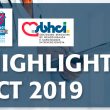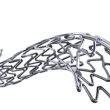Courtesy of the SBHCI. Monotherapy with a P2Y12 inhibitor after a minimum period (3 months) of dual antiplatelet antiaggregation (DAPT) is a valid treatment option to reduce bleeding in patients at high risk of bleeding complications. The present double-blind study presented at TCT 2019 simultaneously published in NEJM analyzed ticagrelor monotherapy (prior 3 months DAPT)<a href="https://solaci.org/en/2019/09/30/tct-2019-twilight-minimal-dapt-in-high-bleeding-risk-patients/" title="Read more" >...</a>
Should Interventional Cardiologists Be Involved in Acute Stroke?
According to this single-site study, published in J Am Coll Cardiol Intv., interventional cardiologists can safely conduct revascularizations in a setting of acute stroke, with high clinical and technical success. Cardiologists are taking on this traditional interventional neurology field simply due to the lack of interventional neurologists, who are thus unable to provide coverage 24/7,<a href="https://solaci.org/en/2019/09/27/should-interventional-cardiologists-be-involved-in-acute-stroke/" title="Read more" >...</a>
Best Conduits and Best Surgeons for the Best Outcome
Myocardial revascularization surgery is still one of the most effective treatment strategies against coronary disease. One of the most important advantages of surgery over angioplasty is the chance to reach complete revascularization. This has proven to improve the survival of patients and to reduce the number of cardiovascular events. The choice of conduit for the<a href="https://solaci.org/en/2019/09/26/best-conduits-and-best-surgeons-for-the-best-outcome/" title="Read more" >...</a>
Revascularization in Spontaneous Coronary Artery Dissection Causing ST-Segment Elevation Myocardial Infarction
Spontaneous coronary artery dissection is an increasing cause of acute myocardial infarction, particularly in younger women. These infarctions are frequently treated conservatively given the risks entailed by revascularization, due to the possibility of causing an antegrade or retrograde expansion of the dissection. The uncertainty around treatment for these patients gave way to this study (recently<a href="https://solaci.org/en/2019/09/24/revascularization-in-spontaneous-coronary-artery-dissection-causing-st-segment-elevation-myocardial-infarction/" title="Read more" >...</a>
DK CRUSH Is Still The Best Option
Courtesy of Dr. Carlos Fava. When it comes to severe unprotected left main distal bifurcation lesions, surgery continues to be the preferred treatment option. However, due to the growing number of patients that cannot receive surgery, left main PCI has significantly advanced, and though the strategy in this scenario remains controversial, double kissing crush stenting<a href="https://solaci.org/en/2019/09/19/dk-crush-is-still-the-best-option/" title="Read more" >...</a>
Thin, Very Thin, and Ultrathin Struts, with Permanent or Biodegradable Polymer… Which Is the Best Combination?
Results from the BIO-RESORT trial at three years, soon to be published in JACC Intv., show that, despite significant differences among stents as regards strut thickness and capability to reabsorb the polymer, there are no apparent safety or efficacy differences among devices. The aim of this study was to determine the three-year safety and efficacy<a href="https://solaci.org/en/2019/09/18/thin-very-thin-and-ultrathin-struts-with-permanent-or-biodegradable-polymer-which-is-the-best-combination/" title="Read more" >...</a>
STEMI in Coronary Dissections. When Should We Do It and What Are Its Outcomes?
Courtesy of Dr. Carlos Fava. Generally, coronary artery dissection (SCAD) is not very frequent in young women and presents better evolution with medical treatment. However, it is occasionally associated with ST segment elevation. In this scenario, PCI with stent implantation is quite challenging. The study looked at 4298 STEMI patients; 53 presented SCAD (1.23%). STEMI-SCAD<a href="https://solaci.org/en/2019/09/17/stemi-in-coronary-dissections-when-should-we-do-it-and-what-are-its-outcomes/" title="Read more" >...</a>
The Most Read Articles of August in solaci website
1-FDA Expands TAVR Indication to Low-Risk Patients Both the self-expandable valve Evolut R and its direct competitor, balloon-expandable valve Sapien 3, received the authorization to be indicated for low-risk patients in a long-awaited announcement made on August 16th, 2019. Read also HERE 2-Mechanisms of Post PCI Persistent Angina Angina persistence or recurrence after PCI can<a href="https://solaci.org/en/2019/09/16/the-most-read-articles-of-august-in-solaci-website/" title="Read more" >...</a>
Is Complete Revascularization the Right Choice in Acute Myocardial Infarction with Multivessel Disease?
Courtesy of Dr. Carlos Fava. Primary coronary angioplasty has been the treatment of choice for acute myocardial infarction (MI) for many years, but such strategy is associated with nonculprit lesions in a large group of patients. While it has been proven that nonculprit-lesion revascularization offers better outcomes, the groups that would benefit from it are<a href="https://solaci.org/en/2019/09/13/is-complete-revascularization-the-right-choice-in-acute-myocardial-infarction-with-multivessel-disease/" title="Read more" >...</a>
Theoretical Advantages Translated into Worst Clinical Outcomes: Synergy vs. Xience
New data from a real-world registry soon to be published in J Am Coll Cardiol Intv suggest that Synergy (a thin-strut everolimus-eluting stent with a biodegradable polymer) is associated with a higher risk of acute stent thrombosis when compared with classic Xience (a thicker-strut everolimus-eluting stent with a durable polymer). At 12 months, there was<a href="https://solaci.org/en/2019/09/10/theoretical-advantages-translated-into-worst-clinical-outcomes-synergy-vs-xience/" title="Read more" >...</a>









